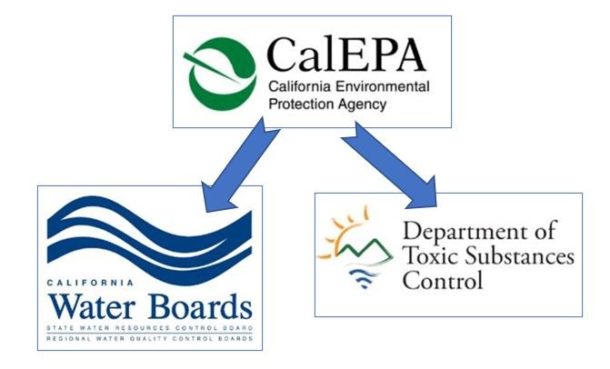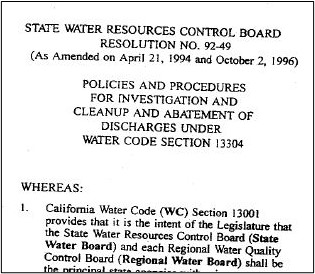How a re-emphasis on Resolution 92-49 by RWQCB will make brownfield cleanups much more costly
The Challenge – RWQCB Pivoting Away from Risk-Based Closures to the Statutory Standard of “Background Conditions”
As western states pivot strategies in response to increasingly severe droughts, the scramble to identify reliable sources of drinking water for their citizens is becoming more intense. Over the coming decades, California expects to receive less water from the Colorado River and expects that Sierra snow melt runoff will decrease. These are two of the biggest sources of drinking water for the Golden State. The value of groundwater as a drinking water source continues to increase in the State as a result of these changing dynamics.
Complicating matters, some of the largest and most prolific groundwater basins in California are impacted by chemical contaminants, resulting from historical industrial, commercial, and agricultural operations that occurred at properties known as “brownfield” sites.
California’s Environmental Protection Agency (Cal-EPA) has two entities that oversee environmental brownfield cleanup projects in the State. The first, DTSC, gets its statutory authority to perform this work from Division 38 of the CA Health & Safety Code. The second, the Regional Water Quality Control Boards (RWQCB), get their statutory authority from the CA Water Code. Their mandates differ but their responsibilities overlap, especially when it comes to brownfield sites. This distinction is becoming more impactful to brownfield owners/developers and remediation companies, as management within RWQCB is transitioning to a more stringent set of standards for site closures, based on a part of the CA Water Code called Resolution 92-49.
First, some background: since the RWQCB began taking an oversight role over brownfield cleanups, there has always been a tacit understanding that remediation has limits; that is, there will always be some minor level of residual contamination in the soil, soil vapor, or groundwater at a cleanup site after remediation has been conducted to its practical limit. What remains after remediation has traditionally been evaluated in light of the potential future risk it poses and the availability of institutional and engineering controls to mitigate risks deemed to be above a “de minimis” level.
In the last year, with pressure from RWQCB management, supervisors within several of the Regional Boards’ Site Cleanup groups have adopted a new policy derived from Resolution 92-49 that eschews the risk-based cleanup goal approach in favor of making “background conditions” the cleanup standard of every remediation project. Murex and our colleagues in the remediation industry have observed this change most acutely in the Los Angeles Region, which could be a reflection of the relatively higher importance of groundwater in Southern California, as compared to Northern California where rivers and reservoirs make up a larger proportion of the drinking water sources. Nonetheless, it will be filtering its way through the entire organization soon enough.
Under this new doctrine, it will no longer be acceptable to propose a cleanup approach that deliberately targets only the highest-impacted source of contamination, while leaving a diffuse surrounding portion untouched. Nor will it be acceptable to propose a numerical cleanup goal other than background, even if it would result in no unacceptable health risk exposure to site occupants. Instead, brownfield practitioners will be required to attempt to clean up to background levels. Further, this change means RWQCB will not approve proposals to install engineering controls in lieu of remediation, since a responsible party must first attempt to remove the contamination resultant from a release to the maximum extent practicable.
The Rub
The engineering and the economics of site remediation haven’t changed. The RWQCB knows there will always be residual contamination in soil, soil vapor, and groundwater after a technology has been implemented to the maximum practicable extent.
In addition, this takes away the quantitative aspect of remediation goals and makes every site evaluation a qualitative practice. Every case manager in every cubicle around the State will be applying their own judgement (for better or worse) against the adequacy of remediation. When government agencies apply potentially uneven qualitative standards in the evaluation of work performed with no objective criteria, it paves the way for inconsistent cleanup standards from site to site. This is antithetical to the goals of 92-49, which was adopted in large part to increase consistency in groundwater cleanups across the nine regional boards.
So why take this stance?
The SWRCB and its Regional Boards are charged with protecting the waters (including groundwater) of the State. If groundwater is to become a more and more important part of the State’s drinking water budget, managers at RWQCB know that they’ll be getting an increasingly pressured focus from Sacramento to hold polluters of that groundwater accountable.
Second, this is a politically defensible position; complaints about unreasonable stringency can simply be answered by pointing to the statute. After all, managers are only doing
what Resolution 92-49 says they are required to do.
The Solution
In light of this change in brownfield site management, Murex is recommending that clients take a thoughtful approach to selecting the agency they will engage for oversight, if they have the option. DTSC’s policies, underpinned by a different set of statutes, remain generally unchanged. If a new voluntary case has yet to be enrolled in an oversight agreement, parties may find it more advantageous to engage with DTSC.
For sites already enrolled in RWQCB oversight, especially those in the assessment and remedial design phase, it is critical to craft the language of site remediation proposals, remedial action objectives, and case closure requests to be consistent with the language of Resolution 92-49. Key concepts should be included in proposals, such as the “substantial likelihood” to achieve cleanup standards within a “reasonable timeframe,” considering what is “technologically and economically feasible.”
Lastly, Murex advises brownfield site representatives to engage with their case manager and supervisor early to discuss how metrics of remediation success will be evaluated, before a remedial design is finalized. Effort and thought invested early will pay dividends when the case closure package is being assembled for management review.
Regulatory Relationships
Murex’s team leaders have forged mutually respectful relationships with senior members of the environmental regulatory community and work to strengthen the cooperation between practitioners and policy makers each year. We strive to advocate on behalf of our clients using sound, technical expertise and state-of-the-practice methodologies that allow regulatory case managers and supervisors to have confidence in our work.
Contact us today for a free, no-obligation consultation on the approach, progress, and plan for closure of your client’s site.

